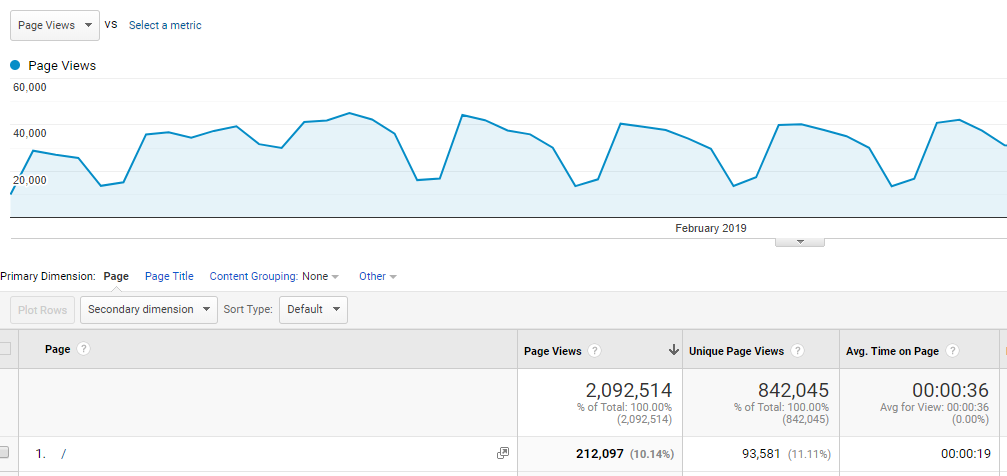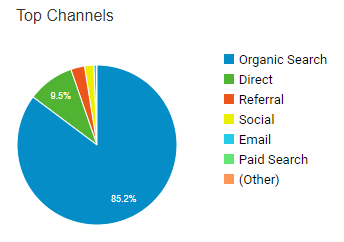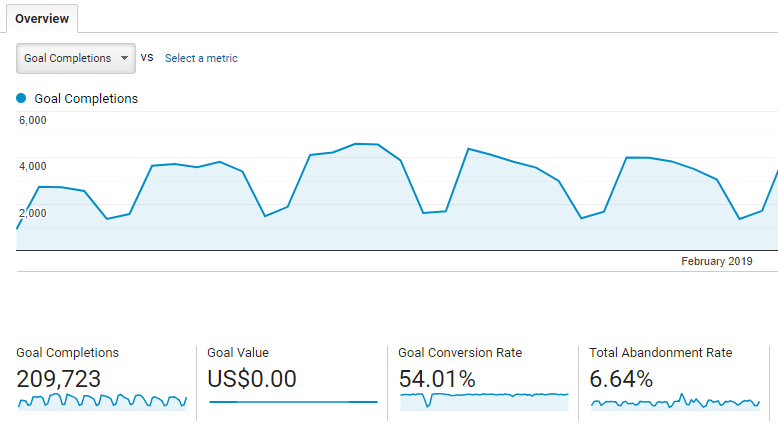Solid digital marketing metrics give you the insight to overcome this barrier of unpredictability. If you’re new to marketing or you need to change your existing marketing strategy, make sure to familiarise yourself with these digital marketing metrics.
Total number of website visits
No matter what type of marketing campaign you are running, you will have to ultimately measure how it is contributing to your website’s traffic growth. Of all the digital marketing metrics, the total number of visitors that your website receives from all sources is an important metric to keep an eye on.

You can also measure total visits to any location relevant to your strategy, such as a landing page for a pay-per-click campaign. Measuring your total number of visits will give you a “bird’s eye view” of how well your campaign is driving traffic. If you notice your numbers drop from one month to the next, you’ll know to investigate one of your marketing channels to figure out why. In a healthy, steady campaign, you should expect your total number of visits to grow steadily.
New and returning website visitors
When it comes to digital marketing metrics, the “new and returning visitors” metric is straightforward and simple to understand. It basically tells you what percentage of people visiting your site have already visited before and how many of them are new. Like any business website, you want people to visit your website again and again because recurring traffic is always valuable. The new versus returning traffic metric helps you understand how well your web content is performing in terms of giving value to your existing visitors. It gives you the opportunity to improve your website’s offering along with your marketing.
Channel-specific traffic
The traffic your website receives has a source of origin. Your channel-specific metrics tell you where exactly you got your visitors from. This, in turn, can help you focus your marketing efforts in the right direction.
“Traffic by Channels” is one of the most crucial digital marketing metrics to watch because it gives you a detailed picture of your traffic. When you know which channel is helping you get the most visitors, you’ll be able to work on it better, especially when you’re running a full-scale digital marketing campaign.
If you look into the “Acquisition” section of your Google Analytics, you’ll find that your traffic is segmented based on the following six sources:
- “direct,” which will tell you how many people visited your site directly;
- “referrals,” which include external links from other sites;
- “organic,” which includes visitors who found you after performing a search;
- “social,” which includes visitors who found you through social media;
- “email”, which indicates traffic from email campaigns, and
- “paid search”, which indicates visitors from your PPC campaigns.
It’s an excellent way to gauge the strengths of your SEO, social media marketing, content marketing, and traditional marketing campaigns.

Bounce rate
The bounce rate shows you how many of your visitors leave your website before further exploring your website. For example, if a potential visitor finds your homepage after searching for you and leaves the page before clicking any other links, they will be considered to have “bounced.” Generally, you want the bounce rate to be as low as possible because the more time someone spends on your site, the more likely they are to convert and perform meaningful actions.

Since every page on your site is different, the bounce rate is bound to differ from page to page. Your homepage may have a lower bounce rate than, for example, your “about” page or “contact” page.

Although the “bounce rate” metric is relative, it does give you a good idea of how well your site is performing in terms of providing relevant content, or if it’s giving an experience your visitors want.
Total conversions
Total conversions is one of the most important metrics for measuring the profitability of your marketing efforts. While it’s possible to define a conversion in many ways (such as filling out a contact form, completing checkout on an e-commerce site, etc.), conversions are always seen as a quantifiable success in the eyes of a marketer. You can measure conversions on your site directly, depending on how it’s built, or you can set up a goal in Google Analytics to track your progress. Low conversion numbers could be the result of poor user experience or disinterested visitors.

Cost per lead
When you’re planning your digital marketing budget, it’s important to know how much you should spend to reach your business goals. Out of all the digital marketing metrics, cost per lead plays a critical role in helping you structure your budget telling you what you should be investing in order to get a qualified lead.
A lead could be your existing customer, but it could also be someone who has only expressed interest in your product/service at some point in time. It’s worth noting that your lead may or may not buy something from you in the future. But still, a qualified lead is valuable for your business just because they have a higher chance of turning into a paying customer.
You can find out the cost per lead by dividing the total ad spend by the total number of leads you were able to generate due to it.
Projected return on investment
The only reason you’re marketing your business online is to ultimately boost your profits. This makes your return on investment (ROI) one of the most important digital marketing metrics to keep track of, highlighting how far your campaign is profitable or not.
When you have a positive ROI, it means that your marketing is working and there are no major changes needed to be made. However, when you see a negative ROI, it means you’re losing money and you have to adjust your marketing strategy.
Calculating your ROI is pretty straightforward:

It doesn’t matter what type of business you are running, if you want it to grow, you cannot ignore your ROI for long. It’s one of those digital marketing metrics that will decide whether your campaign is a success or a failure.
Average time spent on the website
If people like your site, they’ll demonstrate this by simply investing more of their time on your site. The average time spent on your website tells you if visitors find your website useful, and if they liked their experience on it.

Obviously, you cannot and do not need to beat the “time spent on the website” of a popular site like, for example, Wikipedia. But that doesn’t mean you shouldn’t care about it. When more and more people are spending less time on your site, it is a cause of concern. It would be better for your business if you can have them spend a few more valuable minutes browsing your site and connecting with your content.
Interactions per website visit
The “Interactions Per Visit” is obviously a useful metric that needs to be tracked along with others. In order to derive some actionable insights from the measure, it’s important that you understand it well. This means you’ll have to focus on the following variables:
- The number of pages visited by a user.
- The time they spend on individual pages.
- The action they take on each page.
Keep in mind that although interdependent on each other, interactions and conversions are very different. Analysing the interactions per visit metric gives you a better idea of your visitors’ behaviour. You can then use this knowledge to improve your site so that more people spend more quality time on your site.
Website traffic to lead ratio
Quality traffic has a higher chance of converting into quality leads. The more such traffic you get, the more leads you generate. The traffic to lead ratio metric tells you how many visitors to your website converted into leads.
When you analyse this metric, you get a clearer understanding of how targeted and relevant your traffic is as well as how well your website is converting website visitors into real leads. If you’re just starting out with your digital marketing campaign, your traffic to lead ratio may be low or average, depending on your current marketing activities and goals. However, with time as you work on boosting your site’s conversion aspect, you’ll see this ratio improving along the way.







